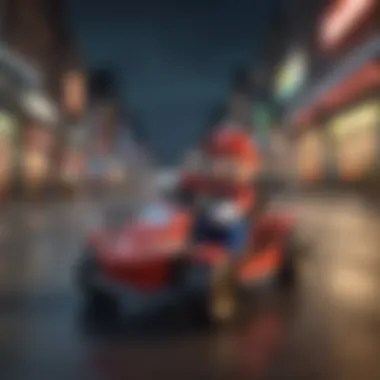Nintendo 3DS and Mario Kart: A Gaming Evolution


Intro
The merger of the Nintendo 3DS system and the ever-popular Mario Kart series marks a significant point in the gaming universe. As one of Nintendo’s most beloved franchises, Mario Kart brings a unique charm infused with nostalgia and competitive spirit. The 3DS not only introduced a new layer of immersion with its distinctive 3D capabilities but also opened avenues for gameplay that were previously unimaginable.
Examining this intersection offers insights into how technological innovations can elevate a classic game while also evolving the player experience. The 3DS added a breath of modernity to Mario Kart without sacrificing the essence that fans adore, making it noteworthy in the realm of gaming history.
This exploration delves into various aspects of this relationship, including the game mechanics, multiplayer dynamics, and the cultural implications that have arisen due to this union. As we dissect the nuances of gameplay, we may uncover lasting impacts on not just gaming culture but also how it shapes interaction among players across various platforms.
With a plethora of elements to consider, let’s first take a closer look at game reviews to set the stage for this examination.
Prelude to Nintendo 3DS and Mario Kart
The synergy between the Nintendo 3DS and the Mario Kart series stands as a compelling point of discussion for both gamers and technology enthusiasts alike. Understanding this relationship not only sheds light on how gaming has evolved but also illustrates the broader cultural impacts of these two stalwarts of the industry. The Nintendo 3DS, with its unique ability to render graphics in stereoscopic 3D without glasses, provided a fresh canvas for game developers to experiment. Coupled with the beloved Mario Kart franchise, which has been a household name since its inception, the intersection of these two created an experience that transcended traditional gameplay dynamics.
Both the 3DS and Mario Kart series brought something distinct to the table: one offered a portable gaming platform capable of dazzling graphics, while the other provided a rich, competitive gameplay mode imbued with nostalgia. The approach that Nintendo took with the 3DS was not merely about portability, but about creating an immersive experience that could draw players into the vibrant worlds they crafted. It becomes even more fascinating when you dive into how the Mario Kart series adapted to this platform, maintaining its core essence while introducing innovations that appealed to both new and veteran players alike. The benefits of this powerful partnership include enhanced social interaction through multiplayer capabilities, more engaging gameplay mechanics, and a broadened audience that includes younger gamers who may have never encountered Mario Kart before.
In this article, we will explore the origins of the Nintendo 3DS, the cultural significance of Mario Kart, and how these elements came together to shape an enduring legacy in gaming. By taking a closer look at the technological advancements and gameplay dynamics introduced by the 3DS, readers can gain invaluable insight into why this intersection is noteworthy.
The Genesis of the Nintendo 3DS
Launched in 2011, the Nintendo 3DS marked a pivotal moment in the history of handheld gaming. It wasn't just another console; it was a bold step into a new realm of visual experience. Gaming enthusiasts were keen to see how the 3D capabilities would influence gameplay. The focusing on producing an engaging experience led to the development of numerous features like the motion sensor and gyroscope. Moreover, Nintendo's leap into augmented reality really highlighted the innovative spirit of the time.
One standout feature is the 3D slider, allowing players to adjust the intensity of the 3D effect according to their preferences. This small touch made a big difference in personalizing the experience. However, what really cemented the 3DS's place in gaming history was the impressive lineup of titles it boasted, which included some iconic franchises alongside Mario, giving players ample reasons to explore the device.
Mario Kart: A Cultural Phenomenon
Mario Kart isn’t just a game; it’s a social current that flows through the gaming landscape. First hitting the shelves in 1992, the series has seen innumerable iterations, each adding new mechanics and refreshing the familiar tracks while enhancing graphics. It's a perfect blend of frenetic racing, strategic power-ups, and a healthy dose of friendly rivalry.
Through the years, Mario Kart has become a staple at parties and gatherings, serving as a bridge that connects people of different ages and backgrounds. The simple joy of racing against friends or family, combined with the chaotic fun of item usage—such as shells, bananas, and the infamous blue shell—ensures that it never grows old. Each release tends to generate not just immediate commercial success but also a buzz across gaming forums and social media. It inspires memes, fan art, and spirited debates about strategies, favorite characters, and best tracks.
The combination of the Nintendo 3DS's portable, innovative technology and the cultural impact of Mario Kart exemplifies how gaming transcends mere entertainment. It brings people together, creates memories, and influences gaming culture at large. As we continue to delve into this article, we will dissect these components further, uncovering the legacy that this partnership has cultivated.
The Technological Advancements of Nintendo 3DS
The Nintendo 3DS brought a significant leap in gaming technology, particularly for handheld devices. At a time when mobile gaming was just beginning to gain mainstream traction, the 3DS set a new standard that others would follow. It wasn’t merely a new console; it was a reimagining of the gaming experience itself. Two key advancements were pivotal: its 3D graphics and enhanced control systems, which collectively transformed how players interacted with games, most notably in the Mario Kart series.
3D Graphics and Immersive Gameplay
The hallmark feature of the Nintendo 3DS is, without a doubt, its glasses-free 3D graphics. This technology allows players to engage with content in a way that feels both fresh and intuitive. As characters and environments extend beyond the screen, players feel as if they are part of the world they are racing in. For games like Mario Kart 7, this depth isn't just a showy gimmick; it fundamentally changes gameplay. The curves of the tracks appear much more pronounced, making the need for precise navigation all the more crucial.
Immersion also comes from how the visual clarity of the 3DS enhances gameplay. Racing at high speeds, players can spot incoming items or hazards more easily. Enhanced visual fidelity shows off Mario Kart 7's vibrant courses, from the lush greenery of the Daisy Hills to the elaborate aquatic backdrop of Cheep-Cheep Beach. This immersion is crucial in a game where split-second decisions can make or break a race.
Additionally, with the incorporation of 3D visuals, the game's visuals can convey important information more effectively, blending form with function. As players drift around corners at hair-raising speeds, the depth of field effects increase the stakes, giving them a real feeling of velocity—a far cry from its predecessors on earlier handheld consoles.
Enhanced Control Systems
Another impressive aspect of the Nintendo 3DS is its refined control systems. The console introduced a new analog stick, known as the Circle Pad, alongside its traditional button layout. This addition allows for nuanced control during races, a significant upgrade from the D-Pad utilized in earlier iterations. Players benefit from precise maneuvers, making it easier to perform sharp turns essential for Mario Kart gameplay.
Furthermore, the 3DS's gyroscopic capabilities offer a unique way to steer by tilting the device. This allows for an additional layer of interaction and engagement that older consoles, such as the Nintendo DS, simply did not offer. Combining the Circle Pad with tilt controls can make for an exhilarating experience as racers weave through tight curves, dodging competitors and obstacles alike.
To top it all off, the integration of StreetPass and other connectivity features provide opportunities for players to challenge one another, making the game inherently more social. This advancement fosters community and competition, allowing gamers to connect beyond the screen.


"The Nintendo 3DS is not just a device for gaming but a portal to a place where stories, challenges, and friendships intermingle."
Mario Kart Titles on the Nintendo 3DS
When exploring the relationship between Nintendo 3DS and Mario Kart, it’s hard to overstate the significance of the titles released on this platform. Mario Kart has consistently pushed the boundaries of racing games, and its presence on the 3DS brought a plethora of innovations that resonated with both long-time fans and newcomers alike.
The 3DS provided an opportunity for Mario Kart to expand its audience. With its unique 3D graphics without the need for glasses, the console allowed gamers to immerse themselves deeper into the vibrant world of Mario Kart. Players found themselves zipping around courses that felt more dynamic and engaging than ever before. But it wasn't just about visuals; the entire gameplay experience evolved.
Mario Kart 7: Innovations and Features
Mario Kart 7, released for the Nintendo 3DS in December 2011, is arguably the crown jewel among the Mario Kart titles on this handheld device. Not only did it mark the series' return to handheld gaming, but it also introduced several game-changing features. For instance, the addition of
- Hang Gliding: This allowed racers to glide through the air, opening up new strategies and shortcuts that players would eagerly look to exploit. It added a verticality to levels that had never before existed in the franchise.
- Underwater Racing: Another significant innovation was the ability to race underwater. This new mechanic required players to adjust their driving style, adding an extra layer of complexity to how races were approached.
- Customizable karts: Gamers could choose parts and create karts that suited their racing style. From lightweight options for speed to heavy parts for stability, the customization opened the door for personal expression in gameplay.
In essence, Mario Kart 7 didn’t just slap on new features; it redefined what it meant to race in the Mario Kart universe.
Comparison with Previous Installments
While Mario Kart 7 is a shining example of progression, placing it alongside previous installments offers a clear picture of how far the series has come. For instance, Mario Kart DS, which launched on the original Nintendo DS, was a groundbreaking title that introduced online multiplayer to the series. Players were keen on connecting and racing against friends far and wide, a feature that was celebrated but limited in scope.
In contrast, Mario Kart 7 enhanced the multiplayer experience by making it even more accessible. The introduction of the
- Coin Rush mode expanded upon the online play, giving players the chance to compete for high scores through time-limited challenges.
- StreetPass functionality allowed players to exchange ghost data with others, leading to unique challenges and an organic way to engage with the community.
With these updates, Mario Kart 7 was not only a leap forward in features but also a reflection of player feedback and changing gaming trends.
In this way, the transition from earlier titles to Mario Kart 7 illustrates the series' commitment to innovation while honoring its roots, ensuring it remains relevant in the ever-evolving landscape of gaming.
Gameplay Mechanics in Mario Kart on 3DS
When you consider the world of racing games, the gameplay mechanics can make or break the experience. In Mario Kart 7, the unique features of the Nintendo 3DS push the envelope, providing players with a refreshing take on how a kart racing game can operate. This section dives into specific elements that contribute to the overall gameplay experience—elements that are crucial not just for competitive play, but for casual gamers looking to enjoy the thrill of the race.
Racing Dynamics and Strategies
Racing dynamics in Mario Kart 7 offer much more than just a basic lap around a track. Each course is designed with a blend of shortcuts, obstacles, and environmental factors that can change on a whim. One can’t just speed through without employing a strategic mindset. Here are some key components:
- Track Layouts: Each track has its own quirks; for example, the Cloudtop Cruise track features both aerial sections and ground loops, forcing players to adapt their driving techniques and strategies as they maneuver through sky and land.
- Character Selection: Characters are not just skin-deep. Choosing the right racer can influence speed, weight, and drift capabilities. Heavier characters, like Bowser, can knock lighter ones off course, while lighter characters, such as Toad, can whip around turns more easily.
- Drifting: Mastering the art of mini-turbos through drifting can be a game-changer. Learning where to drift and when to release gives an edge in races, allowing players to glide ahead of competitors.
The way racing dynamics are set up encourages players to take time in honing their skills, thinking critically about their choices during gameplay. It’s not just about getting to the finish line; it’s about outsmarting your opponents along the way.
Power-ups and Items: A Deeper Look
Items are the heart and soul of the Mario Kart experience. They can turn the tide of a race in an instant, offering both advantages and potential pitfalls. Understanding how to wield these items can influence race outcomes significantly.
- Variety of Items: The range of power-ups—is vast. Whether it is a speed boost from a Mushroom, a protective shell, or a strategic banana peel, each item has its purpose and timing. Knowing when to use a red shell or saving a defensive item for the last straightaway can mean the difference between first and fifth place.
- Item Management: It’s not just about grabbing items; it’s about managing your inventory wisely. Holding onto a defensive item can protect from attack while preparing for an offensive item can set players up for a surprise attack. It’s a tactical balance that one must learn to master.
- Situational Awareness: A good racer must be aware of not just where they are on the track, but what items opponents may have in their arsenal. The sound effects and visual cues can offer insights, such as the unmistakable sound of a blue shell heading your way, prompting a quick decision to act.
"In the game of Mario Kart, timing and strategy can very well piece together the ultimate gambit for victory".
Multiplayer Experience in Mario Kart
The multiplayer aspect of Mario Kart has transformed the way players engage with each other, crafting a more collaborative and competitive environment. The Nintendo 3DS serves as an exceptional platform for multiplayer races, bringing together casual players and seasoned competitors alike. This section examines local and online multiplayer features, as well as community engagement and competitions, illustrating why these elements are vital to the Mario Kart experience.


Local and Online Multiplayer Features
Local multiplayer on the Nintendo 3DS is a joy that invites friends to join in on the wacky, whimsical racing. Players can connect their systems via Local Play, allowing up to eight racers to compete together without the need for an internet connection. This ease of access fosters an inclusive atmosphere, where excitement and laughter fill the room, and rivalries unfold right on the couch.
Conversely, the online multiplayer mode elevates gameplay into a global arena. With the Nintendo Network, players can engage in races with individuals from all corners of the world, further enriching the competition. This mode boasts several features that enhance the experience, including:
- Worldwide Matches: Engage with players across the globe.
- Regional Matches: Compete with players from specific geographical areas.
- Community Cups: Join or create unique events tailored to specific rules or themes.
Through this blend of local and online play, Mario Kart on the 3DS preserves the heart of friendly competition while expanding the horizon of who can join the fun. Players can showcase their skills against friends in their living room or take on opponents from the other side of the planet; either way, the adrenaline is palpable as racers zoom around courses, trying to secure that elusive first place.
Community Engagement and Competitions
Engagement runs deep within the Mario Kart community, especially on the 3DS. Players consistently find innovative ways to connect, share strategies, and form friendships centered around their love for the game. On platforms like Reddit and Facebook, discussions flourish on shared experiences, favorite tracks, and strategies. Further, players often post their best race highlights or wild fails, fostering a sense of camaraderie and rivalry.
Competitions also abound, both informal and structured. Events such as Time Trials, where players race against the clock to achieve the best times, harness competitive energy. In addition, special events or tournaments organized by community members promote friendly competition and sometimes even spark charitable drives. Through these competitions, players can earn a sense of pride and achievement that extends beyond a simple victory on the racetrack.
"In a world where nearly every game has a competitive element, Mario Kart remains unique in its ability to bring people together through laughter, excitement, and the occasional blue shell-induced rage."
Ultimately, the multiplayer experience in Mario Kart isn't just about racing; it’s about creating memories and forging connections that go beyond the screen. By engaging with both local and global players, every race can feel like an epic showdown, a celebration where everyone has an opportunity to shine.
The Impact of Mario Kart on Gaming Culture
The influence of Mario Kart extends far beyond just being a fun racing game. It has carved out a significant niche within the gaming culture, transforming how players engage with multiplayer experiences and social gaming. Never has there been a game that marries high-speed racing with colorful characters quite like Mario Kart. This section delves into the legacy it has built over the years and the crossover appeal that keeps it relevant.
Legacy of Mario Kart Series
Since its inception, the Mario Kart series has evolved but always retained its core essence. Each installment has brought something new while also paying homage to the past, making it a versatile franchise for both nostalgic players and newcomers. The very first game, Super Mario Kart, was released on the SNES in 1992, introducing players to a unique blend of competitive racing, clever circuits, and chaotic power-ups. From kart customization to diverse racing tracks, the series has pushed the envelope with innovation.
Players often hold friendly rivals when facing off in a race. Such moments get captured in stories shared long after the game is turned off. The series is recognized for shaping the genre of kart racing while also creating a legacy of memorable moments.
The games not only foster competition but also camaraderie among players. Take Mario Kart Wii, for example—with its inclusion of online multiplayer and motion controls, it was a game-changer that galvanized entire communities. Add to that the game’s accessibility—easy to pick up yet challenging to master—and you’ve got a recipe for an enduring legacy.
Crossover Appeal and Collaborations
One of the distinguishing features of the Mario Kart franchise is its ability to collaborate with other brands and franchises. This cross-pollination has not only broadened its audience but also made it a cultural touchstone. The sheer joy of racing alongside characters from other series demonstrates how Mario Kart appeals to a wide demographic.
- Nintendo Characters: The series features an array of beloved Nintendo characters, each with their unique abilities, drawing fans not only from the Mario universe but also from franchises like The Legend of Zelda and Animal Crossing.
- Limited-Time Events and Promotions: Games like Mario Kart Tour often include collaborations, offering limited-time events that incorporate popular themes or characters. This creates buzz and eagerness among players, enhancing engagement.
- Merchandising Tie-Ins: Collaborations also extend to merchandise. From apparel to collectibles, Mario Kart has crossed the threshold into pop culture, proving its staying power.
"Mario Kart is more than just a racing game; it’s an experience that brings people together, be it around the same console or through online communities."
The drawing power of Mario Kart has allowed it to thrive across multiple platforms, thus securing its position as a seminal part of gaming culture. By weaving in elements from various franchises, Mario Kart stays fresh and invites a diverse demographic, appealing to various gaming fans.
User Experience and Reception
When discussing the intersection of the Nintendo 3DS and the Mario Kart series, it’s crucial to delve into the user experience and reception that shaped their legacy. This topic is pivotal not just for understanding individual preferences but also for recognizing how these elements influenced overall gaming culture and community dynamics. User experience refers to how players interact with the game and the immersive feelings it evokes, while reception encapsulates both critical acclaim and the sentiments of the player base.
Critical Acclaim and Reviews
Mario Kart on the Nintendo 3DS, particularly Mario Kart 7, received widespread praise from critics and fans alike. Reviewers pointed to the improved graphics, engaging tracks, and the introduction of new gameplay mechanics—like gliders and underwater racing—as significant innovations. The game was often lauded for its accessibility to both novice players and seasoned veterans.
- Graphics and Aesthetics: The vibrant colors and smooth 3D effects made the game visually appealing, enhancing the overall enjoyment.
- Gameplay Mechanics: With features like customizable karts and the ability to race in multiple environments, players found new depths to strategy and play style.


Many reviews highlighted that the experience was not just about winning but unlocking new possibilities and challenges, keeping players coming back for more. According to a review on Wikipedia, it garnered impressive scores from outlets like IGN and Metacritic, emphasizing its place as a standout title on the 3DS.
One notable takeaway is that Mario Kart 7 pushed the envelope for portable racing games. It managed to capture the spirit of competition while maintaining a sense of fun and creativity. As a result, many gamers regarded Mario Kart 7 as a definitive title in the franchise, setting the bar for future entries.
“Mario Kart 7 isn’t just a racing game; it’s an experience that brings people together, delivering pure joy no matter where you play.”
Player Feedback and Community Interaction
Player feedback plays an essential role in shaping the reputation and development of gaming titles. The community surrounding Mario Kart is filled with passionate fans who actively engage with one another, sharing tips, strategies, and feedback on forums like Reddit.
The reception from players often highlighted:
- Community-Driven Content: Fans created myriad videos, tutorials, and live streams showcasing their skills, attracting new players and keeping the community vibrant.
- Multiplayer Engagement: The local and online multiplayer features transformed social interactions, allowing friends and family to share the thrill of racing regardless of location.
Players expressed their appreciation for the constant updates and support from Nintendo. Many noted how these updates addressed concerns related to balance and gameplay quality. The capacity for players to voice their opinions fostered a sense of belonging, which enriched the Mario Kart experience.
In essence, the interaction between user experience and community feedback has allowed Mario Kart to adapt and thrive within the competitive gaming landscape. Balancing critical insights and player sentiments is the lifeblood of evolving gaming franchises, providing a framework for future innovations in the Mario Kart series.
Future of Nintendo 3DS and Mario Kart Series
The future of Nintendo 3DS and the Mario Kart series stands at a pivotal junction. While the Nintendo 3DS may not be as prevalent as before, it carved out a unique niche in gaming history. It’s essential to understand how both the 3DS and Mario Kart can evolve to meet the demands of a rapidly changing industry.
As we look ahead, there are many elements worth considering. Advances in graphics, gameplay mechanics, and player interaction could redefine the gaming experience. Embracing new technology is crucial. It could inspire a fresh wave of content tailored specifically for the 3DS and Mario Kart.
Anticipated Developments and Releases
Players might find excitement in the potential for new titles and expansions. Nintendo has a habit of keeping fans on their toes, often announcing surprises that can elevate their gaming universe. While it’s hard to predict every twist and turn, some developments seem plausible:
- New Mario Kart installment: There’s strong speculation about a new game that incorporates the best aspects of previous titles while adding innovative features. Perhaps a Mario Kart 8 Deluxe level of quality is in the cards?
- DLC Expansions: Existing players can look forward to downloadable content that may introduce new characters, tracks, and special items that further enhance the experience on the 3DS.
- Cross-platform play: In a world where players seek to connect, cross-platform gaming could be a game-changer, allowing 3DS users to compete with console gamers, expanding the community.
- Augmented Reality Features: With the success of AR games, an integration of AR elements might make for a thrilling addition to Mario Kart gameplay.
Evolving Technology and Gameplay Trends
It’s undeniable that technology evolves at breakneck speed, and the gaming industry is no exception. The 3DS, though slightly dated, could still surprise us. Some notable trends include:
- Adaptation to mobile technology: As mobile gaming continues to soar, Nintendo could look at ways to integrate handheld devices and smartphones with the 3DS to enhance multiplayer experiences.
- Advanced AI opponents: With developments in AI, opponents in Mario Kart could become more challenging and realistic, providing dynamic gameplay that adjusts based on a player’s skill level.
- Cloud Gaming: Potential development in cloud gaming could allow for robust graphics and minimal lag, improving how races play out without needing specific hardware upgrades.
- Social Media Integration: Given the rise of social networks, imagine a Mario Kart that allows players to showcase their achievements, share in-game moments, or even compete in community events directly via platforms like Reddit or Facebook.
"In the ever-accelerating world of gaming, innovation remains key. The success of both the Nintendo 3DS and Mario Kart hinges on their ability to adapt!"
The landscape of gaming is shifting, and the future potential of the Nintendo 3DS and Mario Kart can change dramatically. However, it’s this very uncertainty that fuels excitement among fans and provides a fertile ground for creativity. It remains to be seen how Nintendo will navigate these waters, but one thing is certain: the legacy of Mario Kart will continue to influence future gaming while the Nintendo 3DS holds a special place in the hearts of its players.
The End
In bringing together the vivid world of the Nintendo 3DS and the exhilarating content of the Mario Kart series, one uncovers not simply a gaming experience, but a definitive chapter in the history of interactive entertainment. Reflecting on the connection between these two titans leads to a thoughtful appreciation for their indivisible legacy and the cultural fabric they have woven in gaming. The influences of the Nintendo 3DS system extend beyond mere hardware; it served as the canvas for Mario Kart to innovate and flourish, giving players a chance to engage in delightful experiences.
Reflections on the Nintendo 3DS and Mario Kart Legacy
Looking back, the influence of the Nintendo 3DS on the development of Mario Kart is profound. Released in 2011, Mario Kart 7 became not only a showcase for the handheld's capabilities but a turning point for the racing franchise. Features like the ability to pilot underwater or soar through the skies with a hang-glider added layers of complexity that invigorated gameplay. Moreover, the introduction of customizations and new tracks helped to craft a distinctive identity for this version, setting it apart from earlier entries.
The combination of stereoscopic 3D graphics with the vibrant and whimsical tracks became visually iconic. Players could immerse themselves in a world that felt alive, where each racetrack popped with color and detail. The legacy of Mario Kart extends through the bonds it created among friends and families, offering shared laughter and the thrill of competition. Not to mention, Mario Kart 7 contributed to the deepening of competitive gaming culture, inspiring local tournaments and online competitions.
The Ongoing Journey in Gaming
As we gaze toward the horizon, the evolution of gaming experiences amplifies the significance of what the Nintendo 3DS and Mario Kart have achieved. The world of gaming does not stagnate; it continuously shifts toward new technologies and gameplay mechanics. With every passing year, console advancements and innovations in game design push boundaries further than thought conceivable.
Recent trends show that cross-platform play is on the rise, and the merging of gaming communities is more prevalent than ever. This feeds back into the nostalgic admiration of titles like Mario Kart. They remain a reference point that shapes how modern racing games are developed.
Reflecting on this ongoing journey serves as a reminder that gaming remains a social fabric woven of personal connections and shared experiences. Whether through a handheld device like the 3DS or the latest console generation, the spirit of competition and camaraderie that Mario Kart nurtures will continue to fuel the fires of excitement in gaming enthusiasts.
"The thrill of Mario Kart speaks to the heart of competition and friendship, a timeless experience that will endure through evolving technology."



